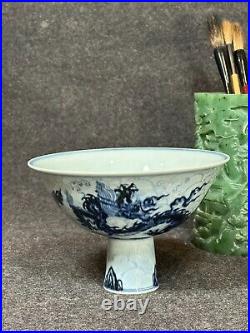
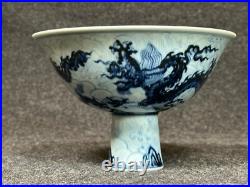
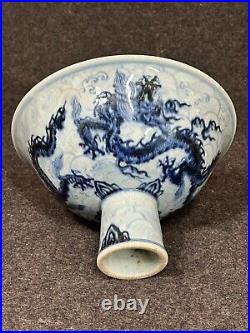
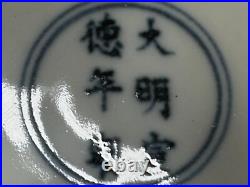

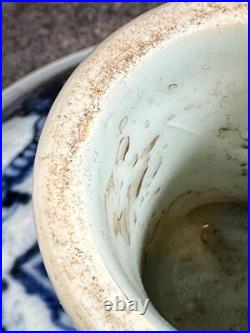















Ming Xuande Blue and White Sea Dragon Stem Bowl. This is a blue and white Stem bowl from the Xuande era 1426 – 1435. The center bears the typical six-character Xuande reign mark. This style of stem bowl evolved from metal drinking vessels used by Mongolians. The stem handle allows drinking while horseback riding. Persian cobalt is used for the underglaze blue. Persian cobalt was available only during the Yuan Dynasty and early Ming Dynasty. It is identified by its brilliant sapphire-like tone, together with its characteristic “heap and pile” effect due to the diffusion of the pigments. Another characteristic is the formation of crystals. Thes are present in all the heavy pigment areas of the vessel. Microscopic Identification and Age Signs. We at Liwen Gallery use microscopic examination to positively identify the period and age of this Xuande charger. The following microscopic features evidence the ancient nature of this porcelain vessel. The underglaze blue pigments are formulated with Persian cobalt. It is identified by formation of crystals from within the glaze. The attached microscope pictures show distinct crystals that require several hundred years to form. This type of cobalt came from the middle east and was available only during the Yuan dynasty and early part of Ming dynasty, up to the middle of the Chenghua era. The presence of Persian cobalt provides evidence that this is from the Ming dynasty since it has never been successfully duplicated with modern technology. Corrosion pits cover the surface of the glaze. These formations only appear on porcelains several hundred years old. Red iron oxide spots and grains are found on the foot rim. These are formed as a result of seepage of iron oxide molecules that coagulate on unglazed surfaces. These can be found on ancient porcelains from the middle of the Qing dynasty and older. All of the above old age signs are evident on the attached microscope pictures. For further discussion on ancient porcelain authentication, please visit the “About” page of our Liwen Gallery website. A Word about Fakes. A simple search would yield a number of porcelain vessels that appear similar to what we offer here. A closer look, however, would show the difference between the production of a four year art student vs artisans who dedicated their entire life creating object d’art for their emperors. Most of them look very old after the artificial aging process. Centuries old porcelains from imperial kilns keep their new look partly due to the high quality of material used, and partly because imperial porcelains are more likely displayed than actually used. Some high quality reproductions can have certain age signs with artificial glaze crackling, discolored bubbles and even cobalt rust spots, but they would appear very different than what we show here with the microscope pictures. Most of our collections came from Europe, and all items in our collection are authenticated by microscopic examination of age signs as well as visual evaluation of material and style consistent with the era. This approach allows us to positively identify period porcelains that cannot be accomplished via traditional visual inspection.

